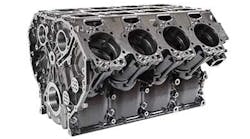Sandvik Additive Manufacturing recently introduced the first diamond composite product ever to be 3D-printed diamond composite part — demonstrating that super-hard materials can be produced in complex shapes for industrial applications. The diamond was exhibited recently at the RAPID + TCT event in Detroit.
Diamond, well known as nature’s hardest material, is a critical element for wear-resistant tooling used in machining. Other industrial uses may be found in mining, and even more critical applications include medical implant design and product.
Since 1953 it has been possible to produce synthetic diamond, but because that material so hard and difficult to machine it’s very difficult to form into complex shapes. Production of super-hard diamond materials has allowed for a just few simple geometric configurations to be formed.
Now, using additive manufacturing and a customized, proprietary post-processing method, Sandvik has arrived at a way to 3D-print diamond composites that can be formed into various shapes.
The difference between Sandvik’s innovation and natural or synthetic diamond is that Sandvik’s is a composite material: Most of the material is diamond, but to make it printable and dense it is cemented into a very hard matrix material, keeping the most important physical properties of pure diamond.
As a result of this (patented) development, diamond components can be created, “application ready” in very complex shapes, with no need for further machining. “Historically, 3D printing in diamond was something that none of us imagined was achievable,” explained Anders Ohlsson, delivery manager at Sandvik Additive Manufacturing.
“On seeing its potential, we began to wonder what else would be possible from 3D-printing complex shapes in a material that is three times stiffer than steel, with heat conductivity higher than copper, the thermal expansion close to Invar – and with a density close to aluminum,” he continued.
“These benefits make us believe that you will see this diamond composite in new advanced industrial applications ranging from wear parts to space programs, in just a few years from now.”
“The additive manufacturing process used is highly advanced,” explained Mikael Schuisky, head of R&D and Operations at Sandvik Additive Manufacturing. “We are printing in a slurry consisting of diamond powder and polymer using a method called stereolithography, where complex parts are produced, layer by layer, using ultraviolet light.”
But, what follows is even more demanding. Sandvik has developed a proprietary post-processing method making it possible to achieve the exact properties of the super-hard diamond composite.
“This step was extremely complicated,” according to Schuisky. “However, after extensive R&D efforts and several trials we managed to take control over the process and made the first 3D-printed diamond composite.”
“Rather than looking to actually develop completely new materials, today the big push within the industry involves the often-radical restructuring of existing materials,” observed Annika Borgenstam, professor at the Department of Materials Science and Engineering at KTH Royal Institute of Technology, Stockholm.
“Using revolutionary new processes, such as additive manufacturing, will open up completely new ways of using the same types of materials that we have today, by building in the properties that we need,” she added.
Another advantage of additive manufacturing is that it allows engineers to minimize material waste. The diamond powder in Sandvik’s process can be extracted from the polymer in the slurry after the printing, and then recycled and reused in another print-job.
The diamond composite has been tested and found to have extremely high hardness, exceptional heat conductivity, while also possessing low density, very good thermal expansion and fantastic corrosion resistance.
“We now have the ability to create strong diamond composites in very complex shapes through additive manufacturing, which fundamentally will change the way industries will be able to use this material. As of now, the only limit to how this super-hard material can be shaped and used is down to the designer’s imagination,” Mikael Schuisky concluded.






